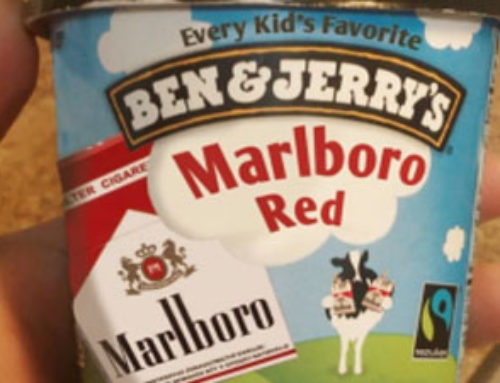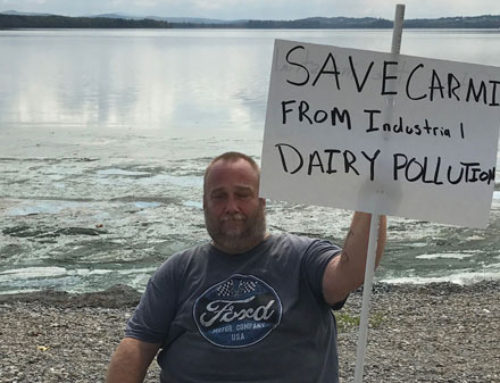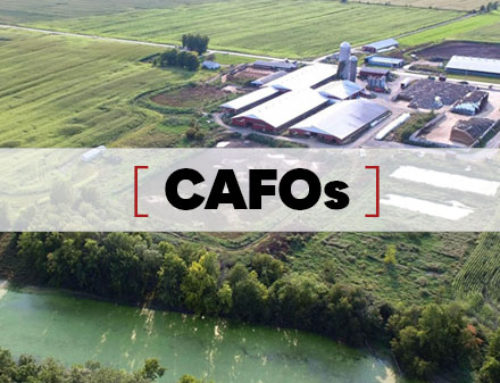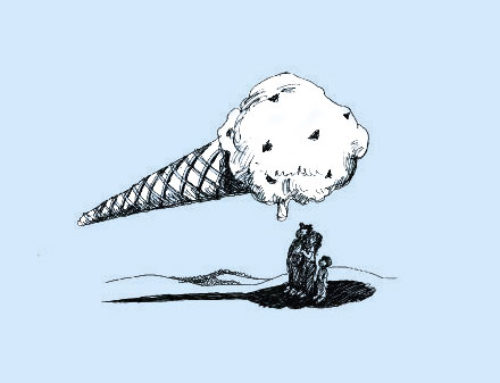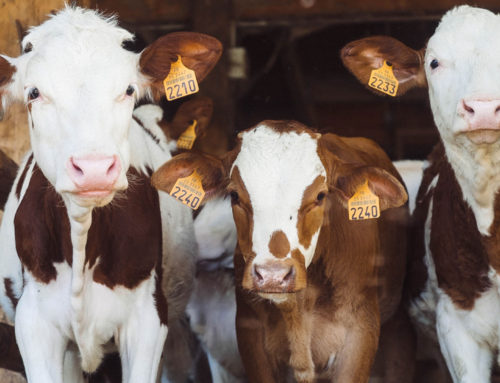By Michael Colby.
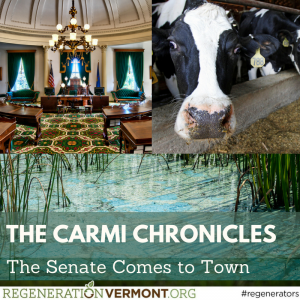 It was a powerful showing at Lake Carmi last month, as nearly 50 citizens showed up on a snowy evening just before Thanksgiving to offer water-quality testimony to a joint hearing of the Vermont Senate, convened by the committees on agriculture and natural resources. The senators came to tiny, tucked-away Franklin to not just hear the public, but to acknowledge the tragedy that has enveloped Lake Carmi and other Vermont waterways, largely as a result of the industrial dairies.
It was a powerful showing at Lake Carmi last month, as nearly 50 citizens showed up on a snowy evening just before Thanksgiving to offer water-quality testimony to a joint hearing of the Vermont Senate, convened by the committees on agriculture and natural resources. The senators came to tiny, tucked-away Franklin to not just hear the public, but to acknowledge the tragedy that has enveloped Lake Carmi and other Vermont waterways, largely as a result of the industrial dairies.
“Welcome to ‘ground zero’ for the state’s water quality problems,” was the greeting they got from Franklin’s Rob Cormier, a retired military man who now lives in an old farmhouse overlooking Lake Carmi. “We are under siege from industrial waste and industrial farming. We have the wrong people growing the wrong crops on the wrong land right now.”
Cormier was among the first of nearly two-dozen citizens who addressed the nine Vermont senators who made the wintry trek, eight committee members and – in the back of the room, just taking it in – the leader of the Senate, Tim Ashe. The parade of public officials who have made their way to Carmi to witness the damage and listen to those most affected by it is, in itself, a testimony to how bad things have gotten. It can no longer be ignored.
The senators had arrived earlier in the day to take a tour of the Carmi area, visiting the area’s confinement dairies, the waterfront, and the tributaries that serve as the passageways for the farm-derived phosphorus to make its way to the once-pristine lake. Franklin County is Vermont’s top dairy producer, home to more than 36,000 cows (and only 48,000 people), producing a staggering amount of phosphorus-rich manure that is spread thickly on the area’s farm fields.
The tour and the public testimony had an obvious impact on two of the Vermont Senate’s most ardent enablers of the region’s industrial dairies, Bobby Starr, long-time chairman of the agriculture committee, and Carolyn Branagan of Franklin County. Not known for acknowledging any damage from confinement dairies, both seemed moved by what they had seen at the lake and were hearing from the community.
“It was enlightening to take the tour and see what a beautiful lake you should have,” said Chairman Starr. “Hopefully we can do things that’ll make life better for you folks.”
“The lake has changed a great deal,” said Senator Branagan, breaking her own silence when it comes to even acknowledging the obvious damage from the mega-dairies. “I’m extremely concerned about that.”
While only words, it is a sign of a significant change in the narrative involving Vermont’s sacred cow – Big Dairy. Now the public awaits some real action from the state’s political and regulatory leaders to back up the talk and “concern.” And they got an earful from the citizens who stepped up, one by one, to the plywood podium to make their case for immediate action, all with respect and mostly within the three minutes allotted to each. It was a magnificent display of democracy, inside the frosty-windowed Town Hall, with plenty of flannel and wet boots, as – finally – the Carmi community had the state’s full attention.
Urgency was the common theme.
“We need help — and we need it this year,” testified Franklin camp-owner, John Barrows, also a member of the local watershed committee. “We don’t need a five-year plan or a 10-year plan or a 20-year plan — we need a one-year plan.”
Barrows submitted just such a plan, too, a detailed ten-point call for immediate action. It should start, according to Barrows, who has the endorsement of the Franklin Watershed Committee, with the Agency of Agriculture using its powers to declare a state of emergency for the area, thus allowing for remedies that go beyond the tepid regulations that have allowed the water pollution to grow worse.
Such an emergency order, prescribed within state law, would allow the secretary of agriculture, currently Anson Tebbetts, to issue site-specific orders such as a ban on any further manure or nutrient applications within the Lake Carmi watershed. Many of those testifying pointed out the obvious: If nutrient overload is the problem, no new nutrients, which leach through the waterways, should be applied until the problem is under control. In other words, turn off the pollution spigot.
In yet another sign of the changing narrative, several of those testifying called for agriculture to no longer be exempt from the state’s most aggressive environmental regulations, particularly those outlined in Act 250. Historically, Vermont has granted farms all kinds of exemptions – everything from tax abatement to lenient registration of farm vehicles.
But nowhere is the hypocrisy more evident than with waste management. While homeowners are understandably forced to hire experts, file all kinds of maps, engineering studies, and fees to put in expensive septic systems for a family’s household waste, farms are exempt from these regulations. This, despite the fact that, according to the U.S. EPA’s data on the waste loads of confinement farms, Vermont’s 135,000 cows create the waste stream equivalent to more than 17 million people. That’s more manure than is created by the nation’s top four cities combined – New York City, Los Angeles, Chicago, and Houston. All untreated and all simply spread about our landscape left to leach and spread as our tributaries and watersheds and final resting places – Lakes Carmi and Champlain, for example — become choked by it.
Another repeated call from those testifying was to move water quality regulation and enforcement out of the purview of the agriculture agency and, instead, put it within the natural resources agency. For too long, both at the federal and state levels, agriculture regulators are charged with two, often contradictory, missions: promote agriculture and police it at the same time.
The results are predictable. As these bureaucracies become “captured” by the industry they are supposed to be regulating, allowing their cheerleading to get in the way of their enforcement, thus “looking away” from practices that clearly violate the public good, the problems mount. And, in the end, the state gets left with a $2 billion-plus water cleanup bill, all because – for way too long – the regulators have been looking the other way when it comes to massive farm pollution.
The Lake Carmi catastrophe may be the tipping point for the much-needed change. As the literal “ground-zero” for the dairy bomb that has been exploding for decades, the Carmi watershed even looks like a bomb’s crater. And this summer, as its water was fouled by the toxic blue-green cyanobacteria, the aftershocks of the pollution rippled through the community. Camps and beaches were closed. Businesses shuttered. And the community — the survivors — were left with the fear and anxiety of what it meant to live and be invested in a place defined by a toxic body of water.
The silver lining in the Lake Carmi tragedy has been the outpouring of inspired community activism, exemplified on the night of Senate testimony and at numerous other meetings that have taken place in Franklin over the last several months. Dozens of townspeople have been trudging out to meeting after meeting in recent months, as a parade of public servants make their way to this proud community to see the damage. And more than just showing up, they’ve been showing up with what the dairy polluters and their regulatory enablers most fear: data and passion.
The Vermont Senate’s visit to Lake Carmi, where nearly a third of its membership came to see and hear from the public, should be a turning point for the state’s dairy dilemma. The public made it clear that inaction will no longer be tolerated, and, better yet, they made the jobs of the politicians and regulators easier by providing a blueprint for the necessary change.
Big Dairy and its polluting ways must be reined in. And, if they won’t change, they must be held accountable for the damage. In every other industrial endeavor in Vermont, the polluter is forced to pay for the cleanup of their messes – think Vermont Yankee and PFOA water contamination.
This is not about “picking on the farmers,” either. It’s about getting out from under a system of farming – industrial, commodity and confinement-based – that is threatening all of us, farmers included. Farming is not the problem, but rather the kind of farming that Vermont has allowed to monopolize nearly 80% of our agricultural land and effort. This kind of single-product economy never benefits the producer or the place, only the corporate benefactors profiting from the cheap milk and labor (Unilever/Ben & Jerry’s and AgriMark/Cabot, for example).
And Lake Carmi is “exhibit A” for the results of this wrongheaded equation, whereby the profits are extracted and the pollution is left behind. But change is in the air, and the great people of Carmi are showing what courage and passion looks like amidst a disaster.
“We want action, not words,” demanded Franklin’s Cormier of the listening senators.
Tick-tock.
Lake Carmi sits in the middle of what is considered “ground zero” for Vermont’s dairy pollution crisis – Franklin County. It’s the state’s top-producing dairy county, home to more than 36,000 cows, almost all of them warehoused in confinement. They are forbidden grazers, never putting a hoof to pasture in their shortened, five-year lives of staggering milk production before an inglorious exit to the meat supply. Read more: http://regenerationvermont.org/the-carmi-chronicles-the-people-vs-big-dairy-vermonters-rise-up-for-clean-water/ Take action: http://regenerationvermont.org/take-action/ Save Lake Carmi
Posted by Regeneration Vermont on Thursday, February 8, 2018
